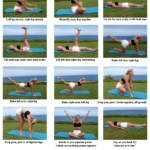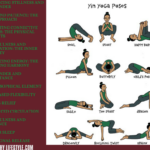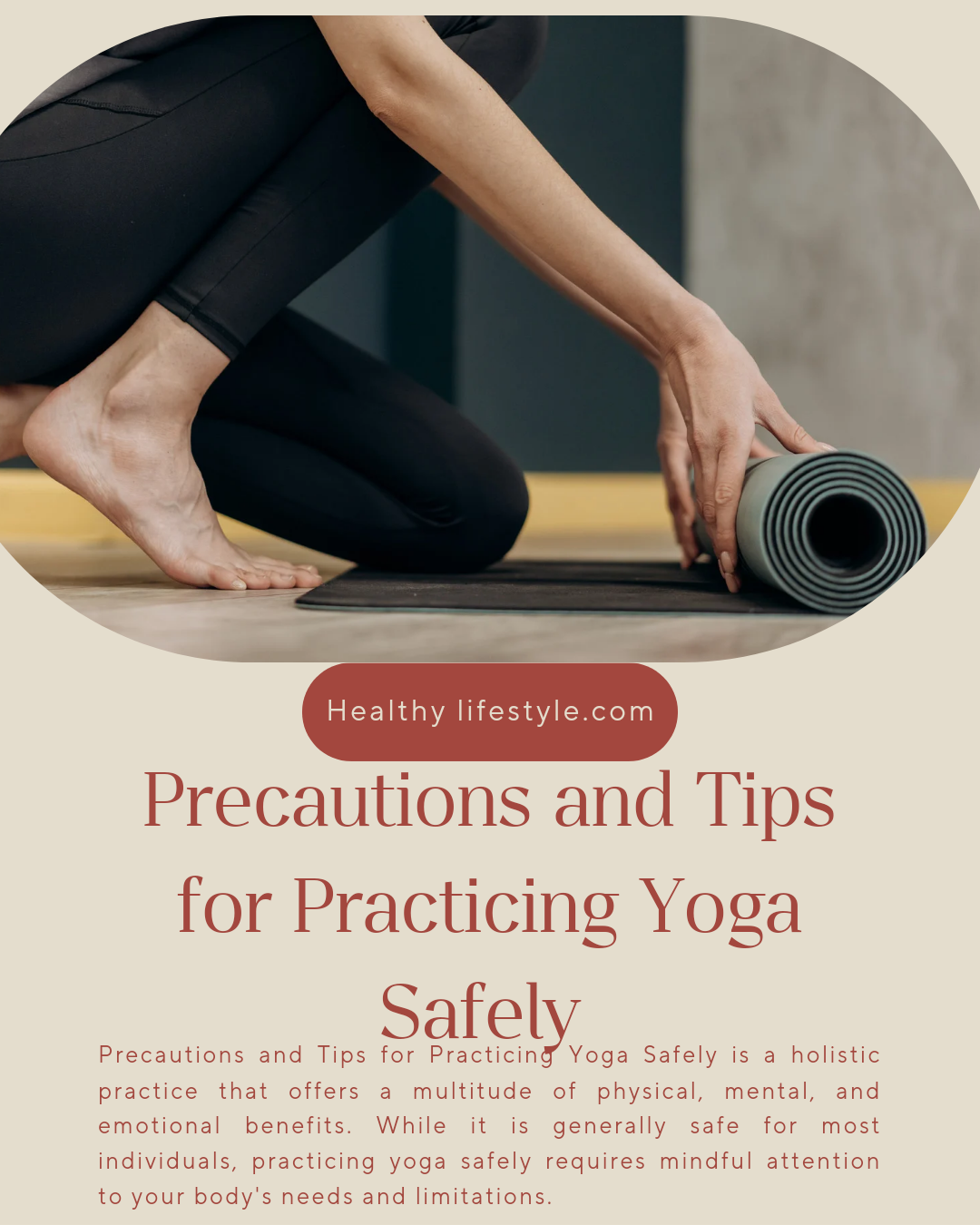Precautions and Tips for Practicing Yoga Safely
Precautions and Tips for Practicing Yoga Safely is a holistic practice that offers a multitude of physical, mental, and emotional benefits. While it is generally safe for most individuals, practicing yoga safely requires mindful attention to your body’s needs and limitations. Whether you’re a seasoned yogi or a beginner, it’s essential to prioritize safety and make informed choices during your practice. Let’s explore a comprehensive list of precautions and tips to ensure a safe and rewarding yoga experience.
Table of Contents
- Introduction
- General Precautions and Tips
- Physical Precautions and Tips
- Breath and Alignment Precautions and Tips
- Mental and Emotional Precautions and Tips
- Prenatal and Special Populations Precautions and Tips
- Conclusion
General Precautions and Tips for Practicing Yoga Safely
| Precautions | Tips |
|---|---|
| Consult a healthcare professional: | Consult your doctor before starting yoga, especially if you have |
| If you have pre-existing medical conditions, | any medical conditions or concerns. |
| injuries, or concerns. | |
| Listen to your body: | Pay attention to your body’s signals. Never push yourself into |
| Honor your body’s limits and avoid forcing | poses or movements that feel uncomfortable or painful. |
| poses. | |
| Choose an appropriate level: | Select classes or poses that match your skill level and experience. |
| Avoid overexertion: | Practice moderation and avoid pushing yourself too hard. |
| Warm up properly: | Begin your practice with gentle warm-up exercises to prepare your |
| Properly prepare your body for more intense | body for more challenging poses. |
| poses. |
Physical Precautions and Tips
| Precautions | Tips |
|---|---|
| Use proper form: | Focus on proper alignment in each pose to prevent strain and injury. |
| Avoid hyperextension: | Be cautious of overextending your joints, especially the knees and |
| Maintain gentle engagement in muscles and | elbows. Engage muscles mindfully to protect joints. |
| joints. | |
| Avoid comparing yourself to others: | Every body is unique. Avoid comparing your practice to others and |
| Focus on your own progress and sensations. | honor your own progress. |
Breath and Alignment Precautions and Tips
| Precautions | Tips |
|---|---|
| Breathe mindfully: | Coordinate your breath with movements and avoid holding your breath. |
| Improper breath control can lead to | Breathing helps to create a sense of ease and flow in your practice. |
| dizziness or discomfort. | |
| Maintain proper alignment: | Pay attention to alignment cues from instructors to prevent strain. |
| Proper alignment promotes safe and effective | Use props if needed to support your body and maintain proper |
| poses. | alignment. |
Mental and Emotional Precautions and Tips
| Precautions | Tips |
|---|---|
| Practice mindfulness: | Stay present and focused during your practice. Avoid distractions and |
| Mindful practice enhances body awareness and | cultivate a sense of mindfulness. |
| reduces the risk of injury. | |
| Respect your emotions: | Yoga can bring up emotions. Allow yourself to feel without judgment. |
| Practice self-compassion and avoid pushing | If a pose or practice feels emotionally overwhelming, take a break or |
| yourself too hard. | choose a different pose. |
Prenatal and Special Populations Precautions and Tips
| Precautions | Tips |
|---|---|
| Consult a prenatal yoga specialist: | If pregnant, seek guidance from a certified prenatal yoga instructor. |
| Prenatal yoga adapts poses to support your | Prenatal yoga can help ease discomfort and promote relaxation during |
| changing body. | pregnancy. |
| Modify poses as needed: | Modify poses to accommodate your body’s needs and limitations. |
| Seniors and individuals with mobility | Explore gentle yoga practices tailored to your specific needs. |
| considerations should seek appropriate | Avoid overly strenuous poses and choose options that enhance |
| modifications. | flexibility and balance. |
Conclusion
Practicing yoga can be a transformative journey that nurtures your physical, mental, and emotional well-being. By prioritizing safety and being mindful of your body’s signals, you can fully enjoy the benefits of yoga while minimizing the risk of injury or discomfort. Remember to consult a healthcare professional, choose the right style and level of practice, and always listen to your body. With these precautions and tips in mind, you can embark on a safe and enriching yoga journey that supports your overall health and wellness.
Incorporating these precautions and tips into your yoga practice can help you enjoy its benefits while minimizing the risk of injury or discomfort. Remember, safety is paramount in any physical activity, and yoga is no exception. By approaching your practice mindfully and respecting your body’s limitations, you can reap the rewards of a safe and fulfilling yoga journey.
FAQs – Precautions and Tips for Practicing Yoga Safely
As you embark on your yoga journey, it’s natural to have questions about practicing yoga safely. Here are some frequently asked questions along with detailed answers to help you navigate your yoga practice with confidence and mindfulness.
1. Is yoga safe for everyone, regardless of age or fitness level? Yes, yoga can be practiced by people of all ages and fitness levels. However, it’s important to choose the right type of yoga and level of practice that suits your individual needs. If you have any health concerns or medical conditions, it’s advisable to consult a healthcare professional before starting a new yoga practice.
2. How do I know if a pose is safe for me to attempt? Listen to your body’s signals. If a pose feels uncomfortable or causes pain, it’s best to ease out of it or modify it. Never force yourself into a pose that doesn’t feel right. Proper alignment and breath awareness are key indicators of a safe and effective pose.
3. Can I practice yoga if I have a pre-existing injury? In many cases, yes. However, it’s important to inform your yoga instructor about any injuries before the class begins. They can provide modifications and alternatives to poses that might aggravate your injury. Yoga can aid in injury recovery and prevention when practiced mindfully and with proper guidance.
4. How can I avoid overexertion during my yoga practice? Mindful awareness is the key to avoiding overexertion. Focus on your breath and body sensations. If you find yourself straining, shaking, or unable to maintain steady breath, it’s a sign that you might be pushing too hard. Take a step back, rest, and come back to the pose when you’re ready.
5. Can I use props even if I’m not a beginner? Absolutely. Yoga props, such as blocks, straps, and bolsters, are not limited to beginners. They can enhance your practice by providing support, improving alignment, and helping you access deeper stretches. Even experienced practitioners can benefit from using props to refine their poses.
6. How can I stay present and mindful during my practice? Mindfulness in yoga involves focusing your attention on the present moment, your breath, and the sensations in your body. To enhance mindfulness, concentrate on your breath throughout your practice and gently redirect your mind if it starts to wander. Remember that yoga is not just about the poses; it’s about the journey within.
7. What should I do if I feel dizzy or lightheaded during yoga? If you experience dizziness or lightheadedness, come out of the pose and rest in a comfortable seated or lying position. Focus on your breath and allow your body to regain its equilibrium. It’s important to stay hydrated and avoid practicing on an empty stomach to prevent these sensations.
8. Can yoga help with stress and anxiety? Yes, yoga has been shown to have a positive impact on stress and anxiety. Mindful breathing, relaxation techniques, and physical movement in yoga can help reduce the body’s stress response and promote a sense of calm. Regular practice can contribute to improved mental well-being.
9. How often should I practice yoga to see results? Consistency is key. Aim for a regular practice that fits your schedule and lifestyle. Starting with a few sessions per week can help you notice improvements in flexibility, strength, and overall well-being. Remember that progress in yoga is gradual, so be patient with yourself.
10. Can yoga be a substitute for medical treatment? While yoga offers many health benefits, it is not a substitute for medical treatment. If you have a medical condition or are undergoing treatment, consult your healthcare provider before starting yoga. Yoga can complement medical care and support your overall wellness, but it should not replace professional medical advice.
Remember that your yoga practice is unique to you. It’s essential to approach it with an open heart, an attentive mind, and a deep respect for your body. By following these precautions and tips and being mindful of your individual needs, you can embark on a safe and fulfilling yoga journey that enriches your physical, mental, and emotional well-being.











